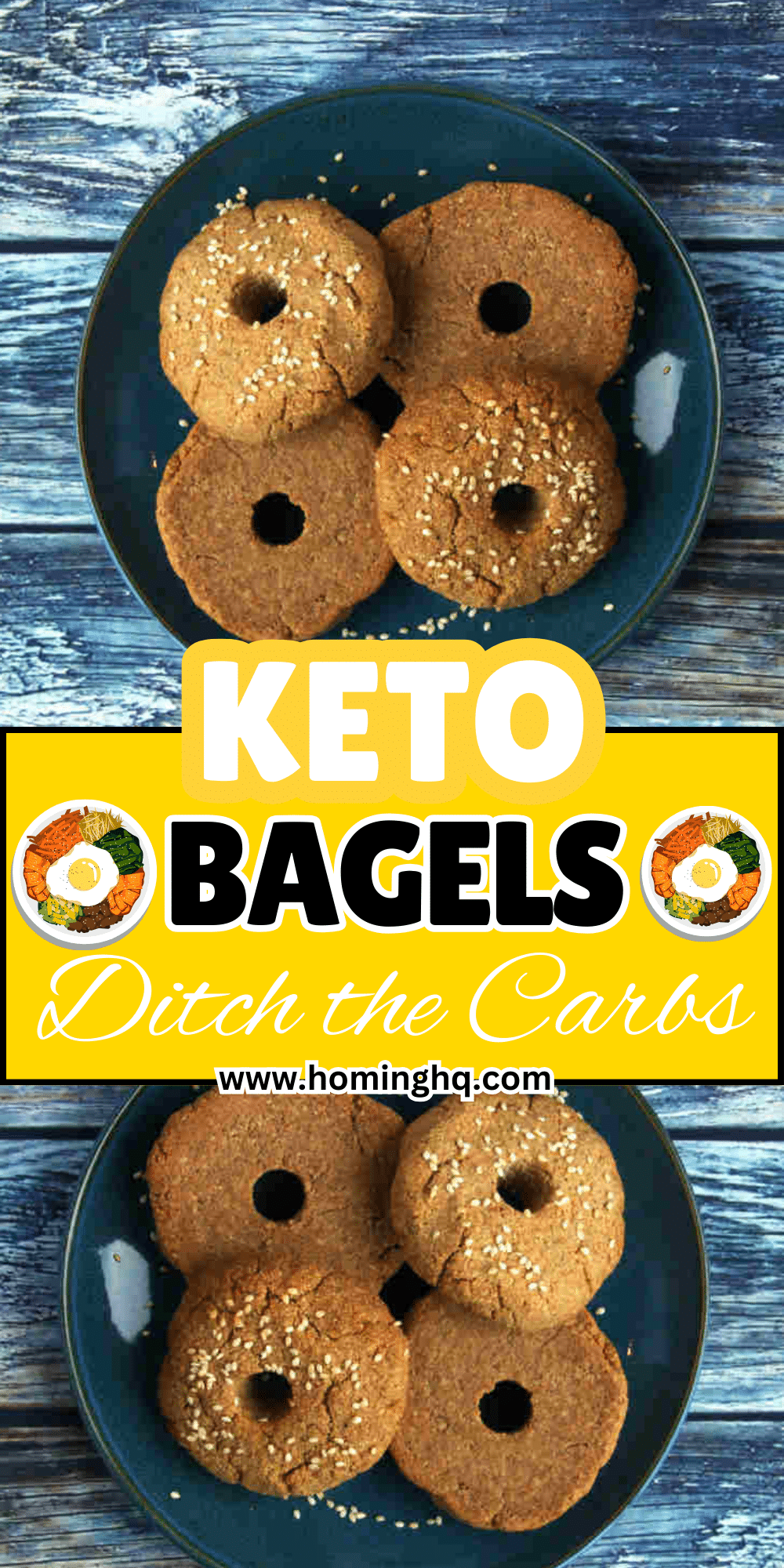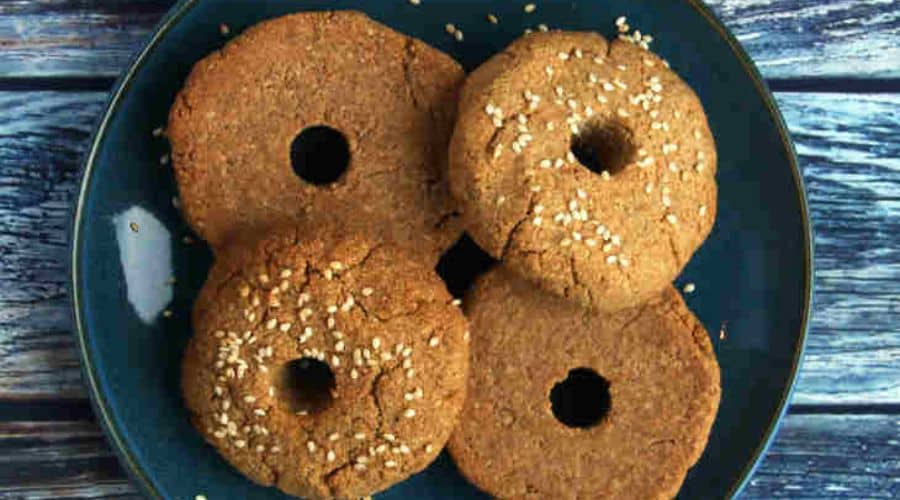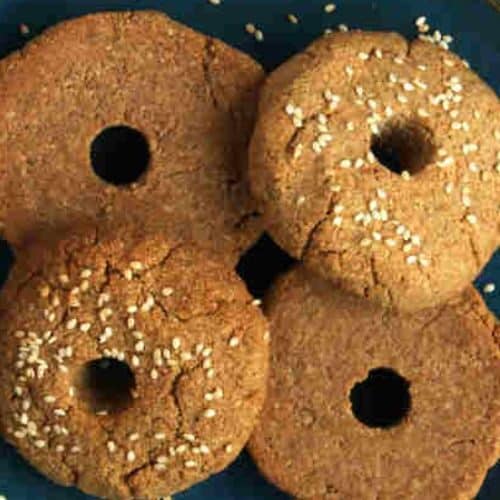All products are selected by our editorial team for quality. If you buy through our links, we may earn a small commission at no extra cost to you.
Keto bagels are a delicious and low-carb alternative to traditional bagels, making them a perfect choice for those following the ketogenic diet.
With a fluffy texture, rich flavor, and the ability to pair with a variety of toppings, these bagels provide a way to enjoy a classic favorite without the carbs.
Unlike regular bagels, which are made from high-carb wheat flour, keto bagels are made using almond flour and other keto-friendly ingredients, making them gluten-free and suitable for low-carb lifestyles.
Whether you’re new to keto or a seasoned pro, keto bagels will satisfy your cravings while keeping you on track with your dietary goals.
There are many reasons to opt for keto bagels.
First and foremost, they’re a great option for anyone looking to reduce their carbohydrate intake without sacrificing taste or texture.
These bagels are not only low in carbs, but they are also gluten-free, making them a good choice for individuals with gluten sensitivities.
Additionally, they offer a satisfying way to enjoy a bagel-like experience without kicking you out of ketosis, the metabolic state that the keto diet aims to maintain.
By switching out traditional high-carb ingredients for low-carb alternatives, keto bagels allow you to indulge while staying true to your health and fitness goals.

Key Ingredients for Keto Bagels
Almond Flour
Almond flour is the cornerstone of most keto baked goods, including keto bagels.
It is low in carbs, high in healthy fats, and provides a moist texture without the gluten found in traditional flour.
Almond flour is a great source of protein and fiber, which helps to keep you feeling fuller for longer, making it an ideal ingredient for keto-friendly recipes.
Psyllium Husk
Psyllium husk plays an essential role in keto bagels by adding fiber and improving the texture of the dough.
It acts as a binder, helping to hold everything together, and provides a chewy, bagel-like consistency.
Psyllium husk also helps with digestion and keeps the bagels from being overly dense, giving them a more authentic feel when baked.
Eggs
Eggs are an integral part of this recipe, serving as the main binding agent for the dough.
They add moisture, structure, and protein, while also helping to lift the dough and create a light, fluffy texture.
The eggs also contribute to the bagels’ rich flavor, making them even more satisfying.
Baking Powder
Baking powder is a key leavening agent in this recipe, helping the keto bagels rise and become light and airy.
Without it, the bagels would be dense and heavy. The small amount of baking powder ensures that the bagels achieve a perfect rise and texture.
Cheese (Optional)
Some variations of keto bagels incorporate cheese, like mozzarella, to add flavor and enhance the texture.
Cheese helps create a slightly crispy outer layer while providing additional moisture and richness.
If you prefer a cheesy bagel, feel free to experiment by mixing in some shredded cheese or topping the bagels with cheese before baking.
Sweeteners
While not always necessary, some keto bagel recipes call for a small amount of low-carb sweeteners, like erythritol or stevia, to add a hint of sweetness.
These sweeteners don’t raise blood sugar levels, making them a good choice for those on a keto diet.
However, if you prefer savory bagels, you can skip the sweetener altogether.
Equipment You’ll Need
Mixing Bowls and Whisks
To combine your dry and wet ingredients, you’ll need a few mixing bowls.
A large bowl for the dry ingredients and a separate bowl for the wet ingredients work best.
Use a whisk to ensure that the baking powder, almond flour, and psyllium husk are evenly distributed in the dry ingredients, and a whisk or hand mixer for the wet ingredients.
Baking Sheet
A baking sheet will be necessary to bake your keto bagels.
It’s best to line the sheet with parchment paper to prevent the dough from sticking and ensure the bagels crisp up nicely.
The size of the baking sheet will depend on how many bagels you want to make, but a standard size should work for most recipes.
Parchment Paper
Parchment paper is a must for this recipe, as it ensures easy removal of the bagels after baking.
Without parchment paper, the bagels may stick to the baking sheet, making it difficult to transfer them without damaging their shape.
Bagel Cutter or Round Molds
To shape your keto bagels, you can use a bagel cutter or round molds.
A bagel cutter will help you form perfectly round bagels, while molds can provide a more uniform shape.
If you don’t have a bagel cutter, you can simply roll the dough into balls and use your fingers to make a hole in the center to form the bagel shape.
Step-by-Step Instructions to Make Keto Bagels

1. Prepare the Dry Ingredients
Begin by combining your dry ingredients in a large mixing bowl. Add almond flour, psyllium husk, and baking powder.
Whisk them together thoroughly to ensure that the ingredients are evenly distributed.
This helps prevent any clumps and ensures that the bagels will have a consistent texture.
2. Mix the Wet Ingredients
In a separate bowl, whisk together the eggs and any additional wet ingredients, such as melted butter or cream cheese.
If you’re using cheese in the recipe, you can also incorporate it at this stage. Whisk the mixture until smooth and homogenous, ensuring that everything is well-combined.
3. Combine Wet and Dry Ingredients
Gradually add the wet ingredients to the dry ingredients. Stir the mixture with a spoon or spatula until a dough-like consistency forms.
The dough should be thick but pliable. If the dough feels too sticky, you can add a little more almond flour to achieve the right consistency.
4. Shape the Bagels
Once your dough is ready, divide it into even portions, depending on how many bagels you want to make.
Roll each portion into a ball and then use your fingers or a round mold to create a hole in the center, forming the classic bagel shape.
Make sure the hole is large enough to prevent the bagel from closing during baking.
5. Optional: Add Toppings
If you’d like to add a bit of extra flavor or texture, now is the time to sprinkle on your preferred toppings.
Sesame seeds, poppy seeds, or “everything bagel” seasoning are popular choices for keto bagels.
Gently press the toppings into the surface of the bagels to help them stick.
6. Bake the Bagels
Preheat your oven to 350°F (175°C). Place the bagels on a parchment-lined baking sheet, ensuring they are spaced evenly apart.
Bake for 20-25 minutes or until the bagels are golden brown on top.
The baking time may vary slightly depending on the size of your bagels, so keep an eye on them as they bake.
Tips for Perfect Keto Bagels
How to Prevent Bagels from Being Too Dense
To avoid dense bagels, make sure you measure your almond flour accurately. Overpacking almond flour can lead to a heavy dough.
Additionally, ensure you’re using enough baking powder to help the bagels rise properly.
A pinch of salt can also improve the dough’s texture and enhance the flavor.
Ensure Bagels Don’t Stick
Parchment paper is your best friend here. Line your baking sheet with parchment paper to prevent the dough from sticking.
You can also lightly grease the parchment paper with oil or cooking spray to make removal even easier once the bagels are baked.
Flavor Variations
Feel free to get creative with your keto bagels! Add herbs like rosemary, thyme, or garlic powder to the dough for a savory twist.
For a sweet version, a dash of cinnamon and a sugar substitute like stevia can create a deliciously warm and comforting flavor.
Cheese can also be incorporated into the dough or sprinkled on top for extra richness.
How to Serve Keto Bagels
Classic Keto Bagel Toppings
Keto bagels are versatile and can be served in various ways. For a classic breakfast, spread some cream cheese on top of your warm bagels.
You can also add slices of avocado, smoked salmon, or turkey for a savory option.
For a more indulgent treat, top your bagel with a little butter or even peanut butter and a sprinkle of cinnamon for a deliciously satisfying snack.
Making a Keto Bagel Sandwich
Keto bagels make excellent bases for sandwiches. Use them to create a hearty keto-friendly sandwich by adding ingredients like eggs, bacon, cheese, and leafy greens.
For a Mediterranean-inspired sandwich, try combining sliced cucumber, tomato, and hummus, or opt for a classic deli-style sandwich with your favorite keto-friendly meats and cheeses.
How to Store Keto Bagels
Once your keto bagels have cooled to room temperature, store them in an airtight container. For optimal freshness, keep them at room temperature for up to 3-4 days.
If you plan to keep them for a longer period, it’s best to freeze them, as they may dry out or become stale if stored for too long at room temperature.
How to Freeze Keto Bagels
To freeze your keto bagels, place them in a freezer-safe bag or container. It’s a good idea to separate the bagels with parchment paper to prevent them from sticking together.
Properly stored, frozen keto bagels will stay fresh for up to 2 months. When you’re ready to enjoy them, simply thaw at room temperature or reheat in the oven.
Reheating Tips
Reheating keto bagels is easy and helps bring back their original texture. To reheat, place the bagel in a toaster or toaster oven for a few minutes.
If using a conventional oven, preheat it to 350°F (175°C) and bake for 5-10 minutes until the bagel is warmed through and slightly crisp on the outside.
Reheating in the oven can also help the bagel retain its chewy interior while crisping up the outside.
Conclusion
Keto bagels are a fantastic way to enjoy a classic breakfast or snack while staying within the parameters of a low-carb, keto-friendly diet.
With a few simple ingredients and a bit of creativity, you can make these bagels your own, experimenting with various flavors and toppings to suit your tastes.
Not only are they a delicious treat, but they also help you maintain your ketogenic lifestyle without missing out on the joy of eating a warm, fresh bagel.
Whether you enjoy them plain, with your favorite spreads, or as part of a hearty sandwich, keto bagels will soon become a staple in your kitchen.
Frequently Asked Questions (FAQs)
1. Can I make keto bagels without almond flour?
Yes, if you’re allergic to almonds or don’t have almond flour on hand, you can substitute it with coconut flour.
However, keep in mind that coconut flour is more absorbent, so you may need to adjust the quantity (typically using about 1/4 to 1/3 of the amount called for in almond flour).
You may also need to add extra moisture to the dough.
2. How do I make these keto bagels dairy-free?
To make your keto bagels dairy-free, simply replace the cheese and cream cheese with dairy-free alternatives.
You can use coconut cream cheese or other non-dairy cheese options. Additionally, replace butter with olive oil or avocado oil for a dairy-free version.
3. Can I make keto bagels without psyllium husk?
Psyllium husk helps to create a chewy texture and bind the dough.
If you don’t have psyllium husk, you can try substituting it with ground flaxseed, although the texture may differ slightly.
Some people also use xanthan gum as a substitute, though it may alter the dough’s consistency.
4. How can I add more flavor to my keto bagels?
You can easily add flavor by incorporating herbs and spices into the dough.
Garlic powder, onion powder, rosemary, or thyme are great choices for savory bagels.
For a sweet variation, try adding cinnamon or vanilla extract. Toppings such as sesame seeds, poppy seeds, or “everything bagel” seasoning can also enhance the flavor.
5. My bagels turned out too dry. What went wrong?
Dry bagels could result from over-baking or using too much almond flour.
Make sure to measure your ingredients correctly and check the bagels a few minutes before the suggested baking time to prevent them from becoming too dry.
Adding a bit more moisture to the dough, like extra egg or melted butter, can also help create a softer bagel.

Keto Bagels
Equipment
- Mixing Bowls (2 large bowls)
- Whisk (1)
- Baking Sheet (1)
- Parchment paper (1 sheet)
- Bagel Cutter or Round Molds (Optional, 1 set)
- Toaster or Oven (For reheating)
Ingredients
- 2 cups 200g Almond Flour
- 2 tbsp 12g Psyllium Husk
- 1 tsp 5g Baking Powder
- 2 large Eggs
- 1/4 cup 60g Butter, melted
- 1/4 cup 60g Cream Cheese, softened (optional)
- 1 tsp 5g Salt
- 1/4 cup 30g Shredded Cheese (optional, for flavor)
- 1 tbsp 8g Sweetener (Erythritol or Stevia, optional for sweetness)
Instructions
Preheat the Oven
- Preheat your oven to 350°F (175°C). Line a baking sheet with parchment paper.
Prepare the Dry Ingredients
- In a large bowl, whisk together almond flour, psyllium husk, baking powder, and salt. Ensure everything is well combined.
Mix the Wet Ingredients
- In a separate bowl, whisk the eggs, melted butter, and softened cream cheese until smooth. If you’re using cheese in the dough, mix it in at this stage.
Combine Wet and Dry Ingredients
- Slowly add the wet ingredients to the dry ingredients and mix well until a dough forms. It should be thick but pliable. If the dough feels too sticky, add a little more almond flour.
Shape the Bagels
- Divide the dough into 6 equal portions. Roll each portion into a ball, then use your fingers to create a hole in the center, shaping them into bagels. Alternatively, use bagel molds to shape the dough.
Optional: Add Toppings
- If you like, sprinkle sesame seeds, poppy seeds, or “everything bagel” seasoning on top of each bagel. Gently press the toppings into the dough to help them stick.
Bake
- Place the bagels on the prepared baking sheet, leaving space between them. Bake for 20-25 minutes, or until golden brown on top.
Cool and Serve
- Allow the bagels to cool slightly before serving. Enjoy them with your favorite keto-friendly spreads or toppings!

